|
BACKGROUND
DEFINITION OF TERMS
HOLINESS
SANCTIFICATION
HOLINESS, HOLY, SAINTS.
The
full background to this teaching is available online at this link
DETAILED DEFINITION OF TERMS
|
Online links to scriptures (New International Version [NIV] unless otherwise stated) are shown in blue
| APOLOGIES FOR LATENESS! |
|
We have had heaps of internet access problems, which we are gradually getting on top of. In Africa, it all takes time.
|
| PHYSICAL DESCRIPTION |
|
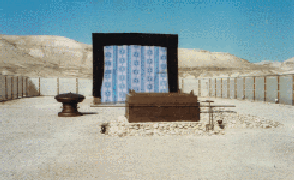 Only the briefest of descriptions of the Tabernacle can be given here. For a fuller explanation, see the book 'Eagles Fly High!' FREE DOWNLOAD HERE
(Photo is of a Replica of Moses Tabernacle, situated in the south of Israel.)
The incredible Tabernacle of Moses, detailed architectural and building instructions for which were given by God himself to Moses on Mt Sinai, as detailed from Exodus 25 onwards.
Exodus 25:8-9
|
| LAYOUT OF MOSES TABERNACLE |
|
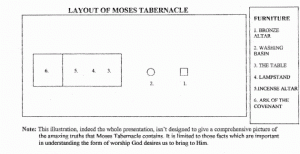 The Tabernacle was God's first church. Prior to the Israelites entering Egypt they were a nomadic people, travelling from place to place in small family groups in order to feed their flocks of sheep and goats. During the 400 years in Egypt, Jewish society developed, settled agriculture skills were learned and a written language acquired. Now God could reveal more of Himself. And Moses could record His church building instructions.
But even more than being the Jews first church, the reason for all the detail was that Moses' Tabernacle was to be a pattern of the Church, past present and future. And a pattern too, for our individual lives. Amazing, really! But true!
So how does this relate to holiness? Let's have a brief look at the layout of the Tabernacle and see.
First of all, the priests and people all had to come in through a single gate. (Where the photo above is taken from.) As can be clearly seen there are no other entrances. The gate is at the right hand end of our diagram. The open area is called the OUTER COURT and is the only area into which people, other than priests, were allowed.
The first item of furniture inside the gate was the Brazen Altar. Upon this altar, blood sacrifices were made. These animal sacrifices were symbolic of that which Jesus would make on the cross, 1500 years later.
Then we move to the Washing Basin. Here the priest washed himself before making a sacrifice. This symbolizes both baptism and the washing of the water of the Word.
To reach the remaining items of furniture it is necessary to enter the Tent. Once again, the tent has but one entrance. A waterproof awning, most likely made out of Sea Cow (a relative of the manatee) skins, covered the tent. It had a bluish tinge to it, and was naturally impregnated with oil. The colour blue and oil are both symbolic of the baptism of the Holy Spirit.
The Tent was divided into two. The first two-thirds was called the HOLY PLACE. Only the priests were allowed inside to attend to the three items of furniture it contained. Inside the door was the Table of Shewbread. It was on this table that each week the priests would place 12 fresh loaves of bread, representing the 12 Tribes of Israel. The bread removed stayed fresh supernaturally, for the priests to eat. This Table represents the 'revelatory' Word of God. The words between the lines, the special understanding the Lord gives to those who move in the realm of the Spirit.
Then we move on to the golden Lampstand. Each morning and evening the priest on duty had to trim the wicks of the seven oil burners of the 'minora' and fill them with oil. The lamp was never allowed to go out. The Lampstand stands for the 'gifts of the Spirit' that Spirit-filled Christians receive from God. These include such things as tongues, prophecy and healing, and the ministry gifts, as the Lord determines.
Finally in the Holy Place, there is the Altar of Incense. On this Altar the priest offered up a specially formulated incense mixture, God's recipe given to Moses. The incense today symbolizes our offerings to God, of praise, worship and prayer.
The final, smallest room was called the HOLY OF HOLIES. The home of the Ark of the Covenant, where the very presence of God dwelt between the two Cherubim on top of the Atonement Cover, or lid, of the Ark itself. The Ark contained three, most precious items to the people of Israel, for each in its own way represented God's supernatural provision and power.
The first was the Jar of Manna. It held a sample of the light, flaky, bread-like substance God provided 6 days a week, to feed the people during the 40 years they spent wandering in the desert, before entering the Promised Land.
The second item was Aaron's Rod. This rod was symbolic of God's authority vested in Aaron. When the people rebelled against Aaron's authority, God made the 'dead' rod bud, blossom and produce ripe almonds - all in a single day!
Finally, the Ark was home to the twin Tablets of the 10 Commandments. These were twice given to Moses on the mountain. The first time God provided the tablets and wrote on them. They were broken when Moses came down the mountain, finding the people worshipping the golden calf. God made Moses drop them, for He cannot live in the presence of sin. The second time Moses made the tablets and God wrote on them. As these replacements were a mixture of God and man, they could remain whole in the presence of the sin they instructed the people against.
Exodus 36:8 - 38:31
|
| OUR PERSONAL JOURNEY TO HOLINESS |
|
Our walk with Jesus is a progressive journey, not a one-time event. We have the ability though, to stop at any point along the way. However, God's desire is for us to become holy, to become like Jesus. Amazingly, the steps we need to take are illustrated by taking a walk through the Tabernacle of Moses. Let's see how.
|
| Brazen Altar: |
|
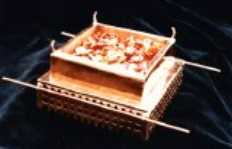 As we come in through the gate, the first and largest piece of furniture we will meet, is the Brazen Altar. Today, it represents the Sacrifice of Jesus, who shed His precious blood for each of us on the Cross of Calvary. Our only available starting point is at the Altar of the Cross of Jesus. There is no other way to holiness except through Jesus and the sacrifice He made for you and me. Good works? No! But by Jesus? Yes!
1 Corinthians 1:17-18
|
| Washing Basin: |
|
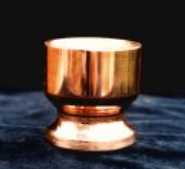 From the Altar we move to the Washing Basin which stands for believers baptism and the washing of the Word. The priests would not dream of entering the Tent without first purifying themselves in the Basin. The symbolic cleansing of baptism, where we publicly put aside the old life and put on the new, while allowing God's word to cleanse and change us, are logical and necessary steps, not for salvation, but on our walk towards holiness.
Galatians 3:26-7
|
| The Tent: |
|
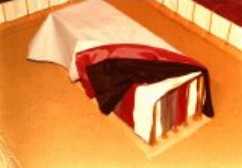 The need to enter the Tent is a stumbling block for many people. For the Tent represents the baptism, the infilling, or release of Holy Spirit power in our lives to teach and change us, so that we might approach the Ark in the Holy of Holies, where true holiness is to be found. Simple human effort will not get us to holiness. Good works, living a good life, people's striving, have been tried so often but always found wanting. This misplaced human effort has been the basic problem of the Holiness Movement. There is only one entrance into the Tent. To get into the Holy of Holies you must enter via the Holy Place.
Acts 8:14-17
|
| Table of Shewbread: |
|
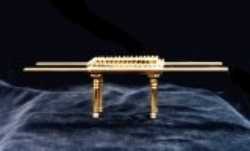 It was on the Table of Shewbread (Showbread) that the priests placed the 12 loaves of bread each week, one for each tribe. These supernaturally stayed fresh and were able to be eaten by the priests after being replaced. The bread represents the Word of God, but this time, as we are now in the realm of the Holy Spirit, it is the 'revelatory' Word. The words between the lines! The understanding of the deeper layers of meaning God's Word contains.
1 John 1:1-7
|
| The Lampstand: |
|
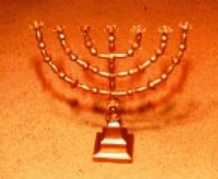 Or candlestick. The Minora, was a lamp whose flame was not allowed to go out. It had to be filled with oil and its wicks trimmed, morning and evening, so the flame would continue to burn. This process represents God's anointing and the Spiritual Gifts He gives us once we enter the Tent, the Holy Spirit's realm.
1 Corinthians 12:1-11
|
| Incense Altar: |
|
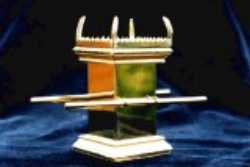 At this Altar the Priests offered up to God the special incense Moses had given the formula for. This speaks of praise, worship and prayer, today's offerings to our Lord for what He has done for us.
1 Peter 1:3-12
|
| To Be Continued Next Week |
|
|
| A REVELATION OF……. THE WAY OF HOLINESSPART 3 OF 9<b>MOSES TABERNACLE - continuedTHE JOURNEY TO HOLINESS 2</b> |
|
 Next week we are continuing our look at Moses Tabernacle. Now entering the Holy of Holies where, unsurprisingly given the name, the principles of holy living are found.
|
| A NOTE FROM DAVID |
|
 Moses Tabernacle is such an amazing source of revelation, even for us today, 3,500 years after it was built!
It clearly illustrates how the development of holiness in our lives is an ongoing process, to be attained through a lifetime of 'walking with Jesus'.
May we walk the walk!
MASADA
Masada is a large rock plateau that creates a desert stronghold in the Judea Wilderness. In Old Testament times, David hid from King Saul in this area. We don’t know that David ever stayed in Masada, but David had surely seen or heard of its huge size and steep cliffs.
During his hiding, David wrote, “The LORD is my rock, my fortress and my deliverer” (Ps. 18:2). In this Psalm, he used the Hebrew word that literally means “masada”—providing a fitting picture of the unshakeable protection and strength of God.
Later, Herod the Great fortified Masada with towers and a high wall. The top of Masada could be cultivated to provide supplies for the defenders. Herod also built a system of cisterns to store water and storehouses to contain necessary supplies.
When Jerusalem during the Jewish Revolts against Rome, the Jewish patriot Eliezer Ben Yair and 960 people with him escaped to the top of the mountain. The Romans spent two years laying siege to the mountain. According to Josephus, when the Romans reached the top, all but five of the people had taken their own lives rather than surrender to the Romans.
Remembering the ancient defeat of these Jews, modern Israeli army recruits swear their oath of allegiance at Masada. They are given a gun and a Hebrew Bible, and they swear to never let Masada fall again.
Source: http://www.followtherabbi.com
|
So until next week.......
MAY GOD BLESS YOU AND YOU BLESS GOD!
His servant and yours

Learn more about us at...
www.wwj.org.nz/about.php
|
A DAVID'S DOODLING
1002. Holiness is an attitude reflected in behaviour.
David Tait
|
Check
out the WWJ website for….
More David's Doodlings: www.wwj.org.nz/dd.php
Everything you ever wanted to know about....: http://www.wwj.org.nz/exex.php
Life's a Laugh: http://www.wwj.org.nz/lifelaugh.php
Links to other sites of interest: http://www.wwj.org.nz/links.php
Till Death do us Part!: http://www.wwj.org.nz/tddup.php
|











